First Drive: Case Puma CVX

Case IH has bust through the 200hp barrier with its new Puma CVX line-up. Nick Fone got hold of the range-topping 225 model
| FW verdict |
|---|
| Case IH has worked hard to stay true to the principles of the original CVX tractors with this new Puma. There is no need to have a degree in software engineering – or any computer ability – to make it work. A complex looking armrest control layout is actually completely the reverse, with all the tractor functions logically labelled and laid-out so that just a push of one the blister-pad buttons makes things happen rather than having to delve into menus and sub-menus in a complicated touch-screen display. That said, working out which throttle-slider setting is best for which job takes a bit of doing. Power is certainly not an issue and the beige-trimmed cab is one of the roomiest and lightest you’ll find. |
It’s a fact not missed by tractor manufacturers, who are all keen to get in on the act. Case IH was one of the first players in this field, launching its 140hp-195hp CVX tractors 11 years ago. Now the company is looking to up the ante, busting through the 200hp barrier for the first time this year with its Puma CVX tractors.
When they are officially launched at Cereals in June, five models will span the 165hp to 225hp bracket, overlapping with the current smaller CVX range.
We got our hands on the top-spec Puma CVX 225 and put it to work with Case’s new LB423 square baler.
Standing menacingly waiting for work, there’s little to give away that this Case Puma is anything special. But it is.
With its inconspicuous CVX suffix, this is the first stepless-transmission Puma to land on UK shores.
Jumping up into the cab it immediately becomes clear that things are different. There’s a computer display terminal, a complex looking control panel with the outline of a tractor at its centre and to top it all off, a shiny, chromed joytsick-cum-gear-lever. All in all, a pretty daunting package.
Fear not, comes the cry from the boys in red overalls – it may look complex, but once you’re used to it it’s a breeze, we’re told.
And they’re not lying. The new Multicontroller has been designed so that it can be used without the aid of the computer’s touch-screen or too much fiddling about with knobs and dials.
Ignoring the blister-pad of buttons that resides beneath your right wrist on the arm-rest, getting things going is simple enough.
| Likes and gripes |
|---|
| + Simple, but comprehensive controls + Smooth ride and transmission + Light, roomy cabin – Somewhat tacky, plastic cab trim – Convoluted start-up procedure – shuttle in neutral and clutch depressed – Lack of analogue gauges |
A flick of the pto switch – not to be mistaken for an egg-cup from a cheap children’s tea-set – sets the soft-start stub-shaft in motion. The computer then trips into Isobus mode and acts as the baler control box.
Next it’s a case of setting the right revs and this is where things become a bit disconcerting. It seems the throttle thumb-slider has split in two, but we’re told its not broken; both are used to set the engine speed.
That done, knocking the shuttle into gear automatically kicks out the electronic parking brake. Be prepared for some strange whirring and grinding from somewhere under the seat. Either a gentle squeeze of the throttle pedal or a push of the chromed gear lever sets things in motion.
Up on the right-hand A-pillar alongside the pto speed readout, a screen displays three target transmission speed settings. Corresponding with this, hare and tortoise buttons on the Multicontroller flick between the three and a thumb-wheel is used to adjust the desired pace.
Ramming the lever right forward or stomping on the throttle will result in the tractor immediately accelerating to that set speed. Pulling back halfway means the pace slackens.
| Case IH Puma 225 CVX |
|---|
| Rated Power 224hp (+23hp pto and transport boost) Engine 6.75-litre Cummins/Iveco/CNH common-rail 6-cyl turbo Transmission Stepless continuously variable transmission 30m/hr-50km/hr Hydraulics 150-litres/min Linkage lift Rear – 10.5t/Front – 3.8t Turning circle 5.6m Weight 7.2t (min) Service interval 600 hours Price £121,551 |
This is particularly useful in the field. The lever stays all the way forwards and the joystick buttons are used to toggle between baling speed, headland turnaround pace and a racier lick for transport.
But to the uninitiated road travel isn’t quite as straightforward and takes a bit more understanding of the twin throttle set-up (see panel). With the slider(s) back to their idle stops, a squeeze of the throttle pedal gets the tractor moving but the engine remains at tickover.
A quick conflab with the boys in red confirms that the right-hand slider needs to be wide open to let the transmission and engine work their magic.
With that sorted, the Puma eagerly races off and is soon purring along at the 50kph target speed. The ride is exceptionally smooth thanks to a suspended cab, semi-active seat and active front-axle suspension.
The brakes are progressive, but positive and they need to be because engine-braking isn’t as you’d expect. Humming along happily at 50kph with a roundabout fast approaching, just easing back on the throttle isn’t enough to slow the big tractor. Right foot action is required.
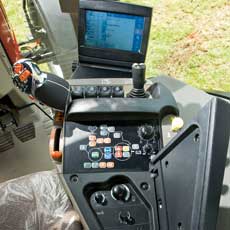 | 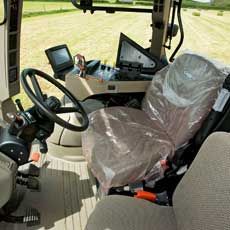 |
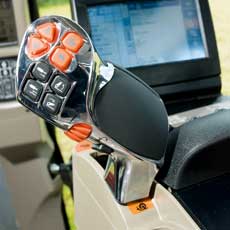 | 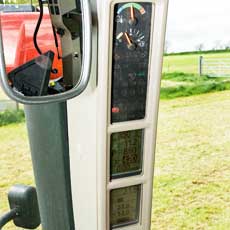 |
The roomy, confortable cab (top right) is home to a shiny chromed joystick and complex-looking control panel (left, top and bottom) but don’t fear, it’s easily fathomed. The right-hand A pillar (right, bottom) is home to all the vital displays.
Throttle thumb-sliders
Driving a Puma CVX is probably the closest most of us will ever come to fast-jet thrills. Although the split twin throttle sliders on the main armrest don’t control a brace of Rolls-Royce Merlins, they do take a bit of understanding.
Put simply, the left-hand slider sets engine revs while the right-hand one sets the amount engine speed can drop before transmission ratios alter to maintain the desired rpm.
That gives three main options:
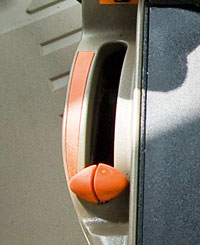 1 Both sliders run together.
1 Both sliders run together.
Setting both throttles alongside each other means the tractor works to maintain the desired engine speed. Consequently, the transmission will accelerate/decelerate with variations in load – maintaining engine rpm is prioritised. Ideal for operations where maintaining a constant pto speed is vital, eg, fertiliser spreading.
2 LH slider ahead of RH
The engine runs at the revs set on the LH throttle, but rpm is allowed to drop to the point set on the RH slider before transmission ratios change. Suited to work where engine loading is likely to be constantly varying, eg, power-harrowing in changing soil conditions.
3 LH slider right back, RH slider forward
The big Cummins 6-pot runs at idle when the transmission is inactive, but pushing the Multicontroller lever forward or using the pedal couples both engine and transmission together. Once the desired forward speed is reached, the power-plant will automatically throttle back until the tractor comes back under load at which point it will ramp back up to maintain the desired forward speed. This is the setting for transport work – on our short road trip with the baler the engine shut right down to 1590rpm once the Puma hit 50kph.
CVX stepless gearbox in a nutshell
When it first appeared on the market in 1998, Case IH’s CVX stepless gearbox was something of a phenomenon. Its clever hybridisation of a four-range mechanical transmission with hydrostatic drive brought a level of versatility to the market that only Fendt could match.
Developed by Steyr in the mid-1990s, the CVX box was swallowed into the giant Case IH corporation when it bought out the Austrian tractor manufacturer in 1996. Two years later CVX tractors went into production, 12 months before Case’s merger with New Holland. Shortly after that the design was sold off to transmission specialist ZF, which builds the box for both blue and red brands, as well as Claas and Deutz.
Over a decade later, the Steyr gearbox has received its first big overhaul, bringing it into the 200hp+ power bracket and allowing it to be fitted to Case IH’s popular 165hp to 225hp mid-range Puma models.
The second generation CVX is a different beast. Built at the Case New Holland transmission plant in Antwerp, it retains four mechanical speed ranges, but borrows some clever gearbox wizardry from the automotive world.
Known as double-clutch technology, it mimics the systems used by Porsche and Audi with two clutch packs handling the stepless shifts between ranges. While the first deals with range one, the second preselects range two. Then as the change up is made, clutch-pack one leap-frogs number two to take on range three, while the second pack pre-selects top gear.
A planetary gearset at the front of the box introduces the hydro element to make ratio changes within each range seamless.
Case says the main advantage of adopting this approach is that mechanical drive is used for a greater proportion of the time and, consequently, efficiency levels are greater than other CVT boxes, which use a greater share of hydrostatic drive.


